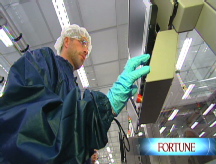Doing well by clearing the air
Investing in carbon credits takes an appetite for risk and complexity. But this market is doing much better than most.
 |
| Consultant Bugnion expects carbon trading to boom if the U.S. joins in. |

 |
| EcoSecurities co-founder Pedro Moura Costa sold a stake to Credit Suisse in 2007; the bank lost millions on the deal, but analysts expect the value of the carbon-credit developer to rebound. |
(Fortune Magazine) -- Has your latest brokerage statement got you down? Maybe it's time to try something completely different: a $96 billion market built entirely on the certifiable absence of a colorless, odorless gas.
That would be the curious and high-growth business of carbon finance. Its primary purpose is to curb global warming by stimulating the trade of a new commodity known as a carbon-emissions reduction credit. Scoff if you like, but know this: During 2008 (through Oct. 15), the value of an index of carbon credits - which you can now purchase on the New York Stock Exchange - grew 5.4%. Can you say that about anything in your portfolio?
What's more, almost everyone expects carbon trading to really take off once the U.S. government regulates greenhouse gases, as both presidential candidates promise to do. Of course, if Washington doesn't act, the market could vaporize. "These are political markets, and you can't take the politics out," says V�ronique Bugnion, an analyst with consultancy Point Carbon.
Carbon finance, in fact, was born of politics: In 2000 the World Bank, under then-president James Wolfensohn, created an investment vehicle called, appropriately, the Prototype Carbon fund. Backed by the governments of Canada, Finland, Japan, the Netherlands, Norway, and Sweden and by 17 companies, including BP, Deutsche Bank, and Mitsubishi, the $135 million fund invested in forests in Romania, hydropower in Costa Rica, and wind farms in China. All the projects were designed to prevent carbon dioxide or other greenhouse gases from entering the earth's atmosphere. They earn one carbon credit for each ton of carbon dioxide or its equivalent in greenhouse gases that they keep out of the atmosphere.
When the European Union began regulating greenhouse-gas emissions in 2005, the credits became valuable. Instead of curbing their own emissions, companies were permitted to purchase credits. A coal-burning utility in Germany, for example, could buy credits to comply with the regulations if doing so was cheaper than switching from burning coal to natural gas.
Wolfensohn, who left the World Bank in 2005, is still playing the carbon market. He and his son Adam are investors in a startup called Verdeo that aims to develop carbon credits in the U.S. Big banks see opportunities too. J.P. Morgan Chase (JPM, Fortune 500) this year acquired a British-based project developer called ClimateCare, which creates credits by deploying efficient cookstoves in Uganda. (The stoves burn less wood, thereby curbing emissions.) Goldman Sachs (GS, Fortune 500) has invested alongside a carbon project developer called Natsource to capture potent industrial gases from chemical plants in China. Recently Greenhouse Gas Services, a joint venture of General Electric and utility company AES, signed an agreement to generate carbon credits for Google (GOOG, Fortune 500), beginning with a project to capture methane gas at a North Carolina landfill. (Google needs credits because it has promised to become carbon neutral.)
Carbon finance is "obviously an enormous market," says Kevin Walsh, a GE Energy executive who is overseeing the joint venture with AES. "We don't go after a business if we think it's going to be a popcorn stand."
So how do you get in on the action? Several British-based carbon-credit developers, including Camco Global (CAO) and EcoSecurities (ECO), are publicly traded on the London Stock Exchange's alternative investment market. Retail investors can also gain exposure to the carbon markets through Barclays IPath Global Carbon ETN (GRN), an investable index that began trading on the New York Stock Exchange in June.
These investments are not for the faint of heart. "It's a very, very risky market and one that few people understand well, including people who are in it," says Ken Newcombe, who ran the World Bank carbon fund and then oversaw carbon trading at Goldman Sachs. Newcombe is about to launch his own carbon finance startup, but he warns that "betting on an individual company requires knowledge of the regulatory climate as well as its ability to manage that risk, which is esoteric." As with any commodity, a rising price for carbon credits doesn't mean that individual companies will prosper.
Even sophisticated investors can get stung. Credit Suisse (CS) bought a 9.9% stake in EcoSecurities in 2007 for about $59 million. Founded ten years earlier by a Brazilian forester named Pedro Moura Costa, the startup failed to produce as many credits as it promised; Credit Suisse's stake is now worth about $12 million. AgCert, another British-based aggregator of credits, went bankrupt earlier this year, and Econergy International, a renewable-energy and carbon project developer, recently agreed to be sold for less than half its market value at the time it went public in 2006.
Still, for investors who are patient, willing to take risks, and prepared to do their homework, the carbon market offers a potentially big upside. "Fundamentally, we like the sector, especially in these grim, grim markets," says Agustin "Gus" Hochschild, an analyst with Mirabaud Securities in London, who argues that EcoSecurities and Camco are significantly undervalued.
Valuing such nascent businesses is more art than science. Neither EcoSecurities nor Camco has made money, but that's no surprise. The work of developing carbon credits is arduous, time-consuming, and costly. Both firms employ close to 300 people, with many dozens scattered around the world looking for cheap ways to curb emissions. Once they develop emissions-reduction projects, they must get them approved by a slow-moving UN regulatory board. Costs pile up before the credits can be sold on the carbon markets in Europe.
Camco, which has amassed $32.6 million in losses since its April 2006 initial public offering, says it will be cash-positive by the end of this year. EcoSecurities, which has lost $102 million since it went public in December 2005, has not said when it will turn profitable. Both stocks have fallen from their IPO price - Camco by nearly 40%, EcoSecurities by about 65%.
Hochschild values the companies by analyzing the projects in their pipelines, just as energy analysts estimate the reserves of coal or natural-gas companies. In that context, the outlook is bright. EcoSecurities has a diverse portfolio - 408 projects in 34 countries, using 18 different technologies - which it says should produce 118 million carbon credits between now and 2012. At today's prices, those credits are worth about $3.1 billion. The firm's market capitalization is $110 million, even though it has about $100 million in cash on hand and no debt. Camco isn't quite as transparent about its portfolio, but its projects are more mature and less risky, analysts say. Its two biggest investors are the Tudor BVI Global Portfolio, a hedge fund led by celebrated money manager Paul Tudor Jones, which owns 13.9%, and Generation Investment Management, the private equity firm led by former Vice President Al Gore and Goldman Sachs veteran David Blood, which holds a 9.5% stake.
"Fairly soon we should see these portfolios generating cash flows," Hochschild says. "Once the companies demonstrate that their business models work, the share price should appreciate."
The trouble is, these back-of-the-envelope calculations are just that. Some projects don't deliver as many credits as promised; it turns out that landfills in the developing world don't yield as much methane gas as expected because poor people don't throw away as much food as well-fed Westerners do. Regulatory delays are expensive. And prices of carbon credits fluctuate, sometimes for arcane reasons.
The single biggest influence on carbon prices is the relative cost of coal and natural gas. That's because the easiest way for utilities to reduce emissions is to switch to cleaner fuels. When natural gas, which is cleaner than coal, gets pricey, that spurs demand for credits. The weather matters too - lots of rain in Spain means low-cost, carbon-free hydropower, less demand for credits, and falling prices. Beyond 2012, when the Kyoto Protocol expires, there are no rules. If regulators worry about the state of the global economy, they may ease up on regulations - good news if you are burning coal, bad news for Camco and EcoSecurities.
On the other hand, if Europe, Japan, and the U.S. are serious about controlling greenhouse-gas emissions, and if China and India go along, the price of controlling emissions will rise, and you might want to invest in a carbon-credit index. Barclays, Merrill Lynch, and Dow Jones have all created indexes tied to the price of carbon, but only the Barclays exchange-traded note, which tracks carbon-credit prices in Europe, is now available to investors.
Carbon prices fell in early October, along with the price of oil and natural gas, but not nearly as far as stocks. "There's very little correlation to the equity markets, which makes it an interesting area for portfolio diversification," says Abyd Karmali, managing director and global head of carbon emissions at Merrill Lynch. Put another way, the very risky business of carbon may be a way to reduce your risk in these turbulent times. ![]()
-
 The retail giant tops the Fortune 500 for the second year in a row. Who else made the list? More
The retail giant tops the Fortune 500 for the second year in a row. Who else made the list? More -
 This group of companies is all about social networking to connect with their customers. More
This group of companies is all about social networking to connect with their customers. More -
 The fight over the cholesterol medication is keeping a generic version from hitting the market. More
The fight over the cholesterol medication is keeping a generic version from hitting the market. More -
 Bin Laden may be dead, but the terrorist group he led doesn't need his money. More
Bin Laden may be dead, but the terrorist group he led doesn't need his money. More -
 U.S. real estate might be a mess, but in other parts of the world, home prices are jumping. More
U.S. real estate might be a mess, but in other parts of the world, home prices are jumping. More -
 Libya's output is a fraction of global production, but it's crucial to the nation's economy. More
Libya's output is a fraction of global production, but it's crucial to the nation's economy. More -
 Once rates start to rise, things could get ugly fast for our neighbors to the north. More
Once rates start to rise, things could get ugly fast for our neighbors to the north. More










